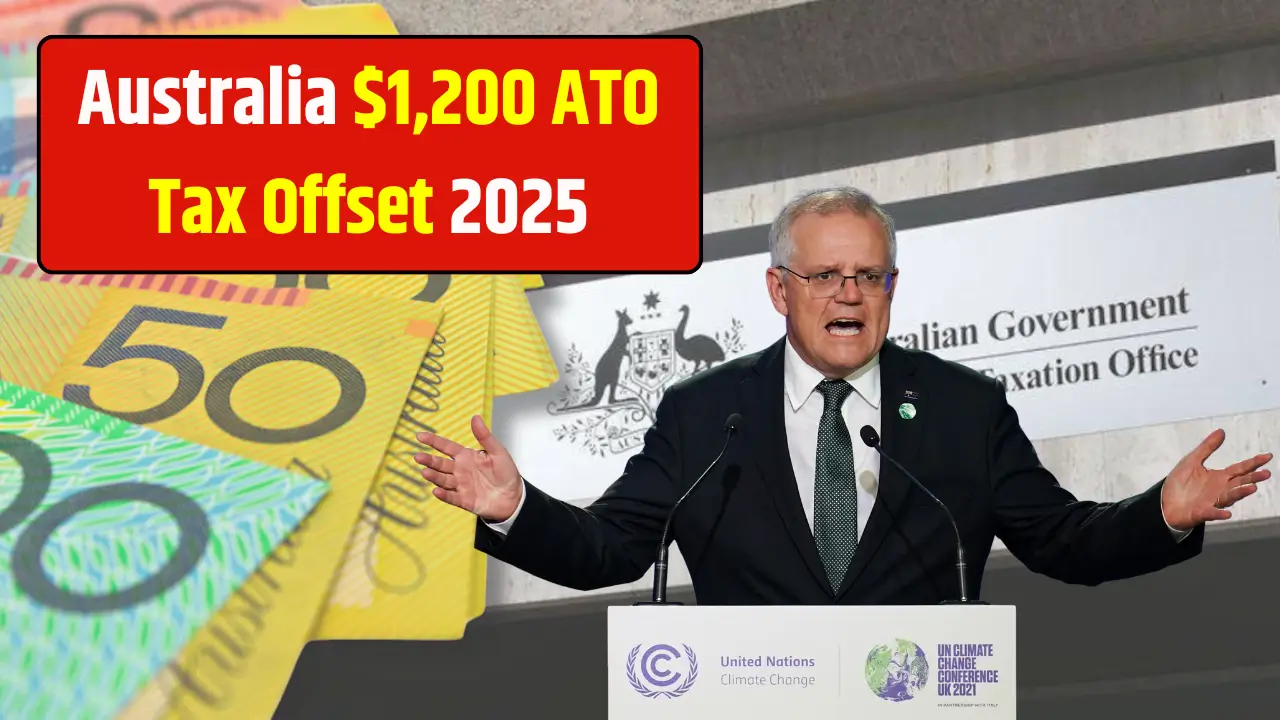Australia $1,200 ATO Tax Offset 2025: The Australian Taxation Office (ATO) is introducing a new $1,200 tax offset for the 2025-26 financial year, aimed at helping millions of Australians manage the rising cost of living.
This tax offset is designed as a non-refundable rebate that directly reduces the amount of tax owed by eligible taxpayers, putting more money back in their pockets. It builds on the government’s continued efforts to support low and middle-income earners through progressive tax relief measures.
This article explains the details of the $1,200 tax offset, who qualifies, how it works, and what taxpayers need to know to benefit from this valuable relief in the 2025 tax return.
What Is the $1,200 Cost of Living Tax Offset?
The $1,200 tax offset, officially called the Cost of Living Tax Offset, is a one-off tax rebate introduced for the 2025-26 income year. It targets Australians experiencing financial pressure due to inflation, increased energy costs, and economic uncertainty.
Key points of the offset:
- The maximum offset amount is $1,200 for individuals with taxable incomes between $48,001 and $104,000.
- Individuals earning below $37,000 receive a smaller offset up to $265, with a gradual increase for incomes between $37,001 and $48,000.
- The offset reduces for taxpayers with incomes between $104,001 and $144,000, decreasing by 3 cents per dollar above $104,000, phasing out completely at $144,000.
- The offset is non-refundable; it can reduce tax owed to zero but will not result in a refund beyond the tax payable.
This tax offset is automatic once taxpayers lodge their returns, requiring no separate claim form for those eligible. It provides immediate relief in reducing tax liabilities amid cost of living pressures.
Eligibility Criteria for the $1,200 Tax Offset
To qualify for the Cost of Living Tax Offset, individuals must meet these criteria:
- Be an Australian resident for tax purposes.
- Have a taxable income below $144,000 for the relevant financial year.
- Pay tax on their taxable income (i.e., not tax-exempt).
- Lodge a tax return for the 2025-26 financial year where the ATO will automatically apply the offset if eligible.
This offset is intended to benefit primarily low and middle-income earners but also provides scaled assistance to those earning up to $144,000.
How the Offset Amount Is Calculated
The offset amount varies based on the individual’s taxable income, as illustrated in the following table:
| Taxable Income Range (AUD) | Tax Offset Amount (AUD) | Notes |
| Up to $37,000 | Up to $265 | Partial tax relief for low-income earners |
| $37,001 to $48,000 | $265 plus 8.5 cents per dollar above $37,000 | Phased increase in offset |
| $48,001 to $104,000 | $1,200 (maximum) | Full tax offset applies |
| $104,001 to $144,000 | $1,200 minus 3 cents per dollar above $104,000 | Gradual phase-out of offset |
| Above $144,000 | $0 | No offset available |
This sliding scale ensures the offset targets those who need the most financial support while phasing out at higher incomes to maintain progressive tax equity.
How the $1,200 Tax Offset Helps Australian Taxpayers
By reducing the amount of tax owed dollar-for-dollar, the tax offset increases disposable income for millions of people. This extra liquidity can help individuals and families manage day-to-day expenses such as:
- Rising household energy bills and rents.
- Food and fuel price increases due to inflation.
- Healthcare and schooling costs.
The offset delivers direct tax relief without requiring changes to tax brackets or rates, making it a straightforward and fast way to help taxpayers amid economic challenges.
Interaction with Other Tax Offsets and Benefits
It is important to note that:
- The Cost of Living Tax Offset is non-refundable and will reduce tax payable to zero if applicable but will not generate refunds beyond any tax liability.
- Taxpayers may still be eligible for other tax offsets or benefits such as the Low Income Tax Offset (LITO), Seniors and Pensioners Tax Offset, or the Private Health Insurance Rebate, which can be claimed alongside this offset if eligible.
- The offset is automatically calculated by the ATO during tax return processing — no manual claim is necessary.
Taxpayers should ensure accurate income reporting and claim all applicable offsets to maximise their tax benefit.
Table: Summary of Key Tax Offsets for 2025-26
| Tax Offset | Maximum Amount (AUD) | Eligibility Highlights |
| Cost of Living Tax Offset | $1,200 | Taxable income up to $144,000 |
| Low Income Tax Offset (LITO) | Not available (ended) | Previously up to $1,080 (2018-2022 income years) |
| Seniors and Pensioners Tax Offset | Up to $2,230 | Seniors and pensioners meeting income criteria |
| Private Health Insurance Offset | Variable | Based on premiums paid for PHI |
| Zone Tax Offset | $57 to $1,173 | Residents of designated remote or isolated areas |
How to Prepare for the 2025-26 Tax Return
To ensure receiving the $1,200 Cost of Living Tax Offset (if eligible), taxpayers should:
- Maintain accurate records of taxable income and any supporting documents.
- Lodge tax returns promptly for the 2025-26 financial year — the offset will be applied automatically by the ATO.
- Verify personal details with the ATO, especially if income sources or residency status change.
- Consult with tax professionals or use government tax agents to maximise allowable escapes and offsets.
Proactive tax planning can help optimise benefits from this and other tax relief measures.
Government Perspective on the $1,200 Tax Offset
The Australian government introduced the Cost of Living Tax Offset to help Australians navigate ongoing economic challenges driven by inflation, global market fluctuations, and domestic cost pressures.
The program is seen as a targeted approach to provide immediate financial relief without altering broader tax policies.
Policymakers emphasise the offset’s role in reducing financial stress for middle-class earners who might not qualify for other social supports while ensuring fairness by phasing out at higher incomes.
This initiative aligns with Australia’s ongoing fiscal strategy to balance economic recovery with social equity.
Conclusion
The $1,200 ATO Cost of Living Tax Offset in the 2025-26 financial year is a valuable tax relief measure aimed at helping millions of Australians manage rising living expenses.
Eligibility depends mainly on income and residency status, with a phased benefit scale rewarding low and middle-income earners. Automatic application by the ATO makes it an accessible benefit requiring minimal effort from taxpayers.
Understanding eligibility, income thresholds, and how to prepare financial records can help Australians fully leverage this offset to ease tax burdens and improve financial well-being.
FAQs
Q1: Who is eligible for the $1,200 ATO tax offset?
Australian residents for tax purposes with taxable incomes below $144,000 during the 2025-26 financial year are eligible.
Q2: Is the $1,200 tax offset refundable?
No, the offset is non-refundable and can only reduce tax payable to zero without generating a refund beyond tax owed.
Q3: Does a taxpayer need to apply separately for this tax offset?
No, the ATO automatically applies this offset once an eligible tax return is lodged.
Q4: Can I claim this tax offset along with other tax offsets?
Yes, you may still be eligible to claim other tax offsets, such as the Seniors and Pensioners Tax Offset or Private Health Insurance Offset.
Q5: How does the tax offset amount change with income?
The offset amount phases in from $265 at $37,000 income, peaks at $1,200 between $48,001 and $104,000, and phases out completely at $144,000 income.















